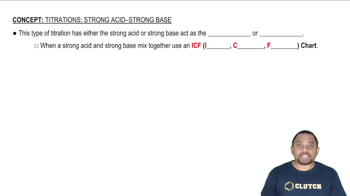Here are the essential concepts you must grasp in order to answer the question correctly.
Acid-Base Titration
An acid-base titration is a quantitative analytical method used to determine the concentration of an acid or base in a solution. During the titration, a solution of known concentration (the titrant) is added to a solution of unknown concentration until the reaction reaches its equivalence point, where the amount of acid equals the amount of base. The pH at this point can vary depending on the strengths of the acid and base involved.
Recommended video:
Weak Base and Strong Acid
In the titration of a weak base, such as ammonia (NH3), with a strong acid like hydrochloric acid (HCl), the resulting solution at the equivalence point contains the conjugate acid (NH4+) of the weak base. This conjugate acid can donate protons to water, leading to a decrease in pH. Therefore, the pH at the equivalence point will be below 7, indicating an acidic solution.
Recommended video:
Strong Acid-Strong Base Titration
pH Scale and Equivalence Point
The pH scale measures the acidity or basicity of a solution, with values below 7 indicating acidity, 7 being neutral, and above 7 indicating basicity. The equivalence point in a titration is critical for determining the pH of the resulting solution. For titrations involving a weak base and a strong acid, the pH at the equivalence point will typically be less than 7 due to the formation of a weakly basic conjugate acid.
Recommended video:





